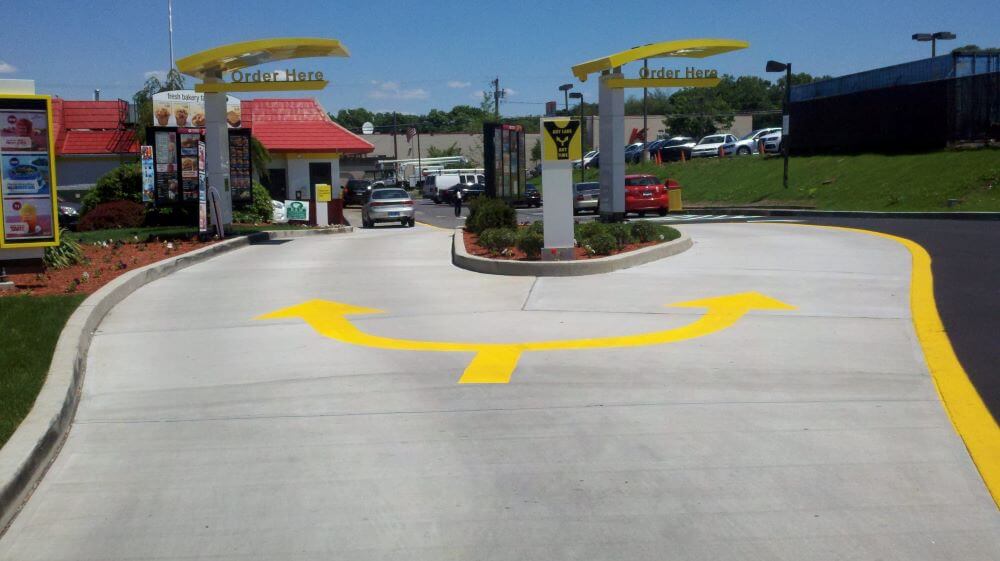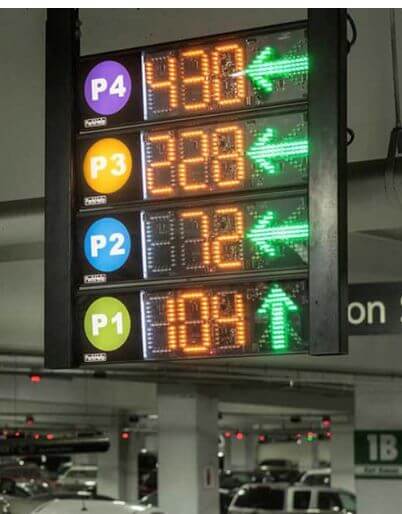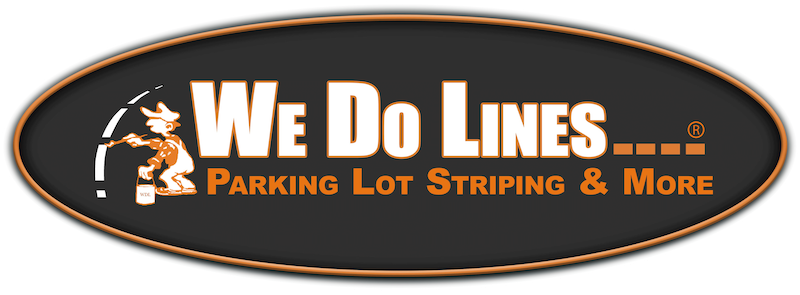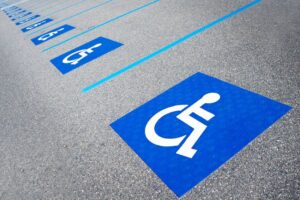Navigating the intricate dance of vehicles within a commercial property is an art, and the unsung hero orchestrating this symphony is directional signage. These signs do more than guide; they ensure the smooth flow of traffic, enhancing both safety and efficiency. In this blog, we dive into the pivotal role of directional signage in commercial spaces, exploring its significance, best practices for implementation, and the latest innovations that are changing the way we manage traffic flow.
The Significance of Directional Signage
Directional signage transcends its apparent simplicity. Beyond being mere markers, these signs are strategic tools designed to ensure smooth vehicular circulation across commercial properties. Their importance cannot be overstated, as they directly impact several key aspects of business operations and visitor experience.

Customer Experience and Business Efficiency
First impressions are lasting, and for many customers, their journey through a parking lot or commercial complex is the first interaction they have with a business. The ease with which they navigate this space can set the tone for their entire visit. Efficiently designed and strategically placed directional signage can transform a potentially confusing and frustrating experience into a seamless and pleasant one. By minimizing delays and preventing congestion, businesses can significantly enhance customer satisfaction, potentially increasing repeat visits and, by extension, profitability.
Safety and Liability
From a safety perspective, the importance of clear, visible, and accurate directional signage cannot be overstated. These signs play a critical role in minimizing the risk of accidents by guiding vehicles along preferred routes, indicating pedestrian crossings, and signaling changes in traffic patterns or hazards. Moreover, well-implemented signage can help businesses mitigate liability risks associated with vehicle accidents on their property.
Regulatory Compliance and Accessibility
Compliance with local and national regulations is another crucial aspect of directional signage. Adequate signage ensures that commercial properties meet legal standards for accessibility and safety, avoiding potential fines and legal challenges. Furthermore, inclusive signage design also accounts for the needs of all users, including individuals with disabilities, ensuring that commercial spaces are accessible and navigable for everyone, which is not only a legal requirement but also a best practice in customer service.
Enhancing Traffic Flow
The core function of directional signage is to facilitate the efficient flow of traffic, a task that requires careful planning and understanding of traffic dynamics. The design and placement of signs are guided by several principles aimed at maximizing their effectiveness.
Strategic Placement and Design
The effectiveness of directional signage in enhancing traffic flow hinges on its strategic placement and design. Signs must be placed at key decision points where drivers need information to make navigation decisions. This includes entrances and exits, intersections within parking lots, and points where traffic patterns change. The design of these signs must be intuitive, with clear symbols or text that can be understood at a glance, and reflective materials that ensure visibility at night or in poor weather conditions.
Impact on Traffic Patterns
Well-placed directional signage can significantly influence traffic patterns, encouraging the use of certain routes over others and distributing traffic more evenly across the property. This can prevent congestion in high-traffic areas, reduce the risk of accidents, and improve the overall flow of vehicles. By guiding drivers along the most efficient paths, businesses can ensure that traffic moves smoothly, even during peak times, enhancing the overall efficiency of the property.
Case Studies and Best Practices
Examining successful implementations of directional signage in commercial settings can provide valuable insights into best practices and innovative approaches. For instance, large shopping centers and sports complexes often employ a combination of fixed signage and variable message signs (VMS) to manage traffic effectively during varying levels of demand. These case studies highlight the importance of flexibility in signage strategy, allowing for adjustments based on current traffic conditions or specific events, thereby optimizing traffic flow and enhancing safety.

Best Practices for Implementation
Implementing directional signage effectively is paramount for enhancing traffic flow and ensuring safety on commercial properties. The following best practices are essential for businesses looking to leverage the full potential of their directional signage:
Visibility and Clarity
The primary purpose of directional signage is to guide and inform. Therefore, visibility and clarity are fundamental. Signs should be large enough to be easily read from a distance and positioned at eye level to ensure they catch the eye of drivers and pedestrians alike. High-contrast colors and reflective materials are recommended to enhance visibility during all hours and in varying weather conditions. The use of universally recognized symbols and minimal text can further improve clarity and quick comprehension.
Strategic Placement
Signage should be strategically placed at decision points where individuals need guidance on where to go next. This includes entrances, exits, intersections, and parking areas. Placement should consider the driver’s perspective, ensuring signs are visible well in advance of the decision point to allow for safe maneuvers. Additionally, signs should not be placed where they could be obscured by obstacles such as trees, buildings, or other signs.
Consistency and Continuity
Maintaining consistency in design and messaging across all signage within a property helps reinforce navigation cues. Consistent use of colors, symbols, and sign shapes can aid in quick recognition and action. Continuity in signage ensures that once individuals are on the correct path, subsequent signs lead them through their journey without confusion or interruption.
Compliance and Accessibility
Adhering to local regulations and standards is not just a legal requirement; it also ensures that signage is effective and accessible to all users. This includes compliance with the Americans with Disabilities Act (ADA) in the United States or similar legislation elsewhere, which stipulates guidelines for signage to accommodate individuals with disabilities. Ensuring accessibility in signage involves the use of Braille for the visually impaired, as well as considering placement height and visibility for those in wheelchairs.
Regular Maintenance and Evaluation
The effectiveness of directional signage is not set-and-forget. Regular maintenance is required to ensure signs remain visible, legible, and accurate. This includes cleaning, repairing, or replacing signs as needed. Periodic evaluations should also be conducted to assess the effectiveness of the signage system, making adjustments based on changes in traffic flow, property layout, or feedback from users.
Innovations in Directional Signage
The evolution of technology has brought about significant innovations in directional signage, offering new ways to manage traffic flow and enhance user experience.

Smart Signage
Smart signage represents a leap forward in traffic management, utilizing IoT (Internet of Things) technology to collect and analyze data in real time. These signs can adjust their messages based on current traffic conditions, events, or time of day, guiding drivers via the most efficient routes. For example, digital signs at a shopping center can redirect traffic away from full parking areas to those with available spaces, greatly improving the parking experience and reducing congestion.
Digital and Interactive Signage
Digital signage offers flexibility that traditional signs cannot, displaying dynamic content that can be updated as needed. This is particularly useful in complex commercial environments where events, traffic patterns, or available services may change frequently. Interactive signage, equipped with touchscreens or QR codes, allows users to receive personalized directions, information about shops or services, and even real-time updates about their destination.
Mobile Integration
The integration of directional signage with mobile technology is a growing trend. Mobile apps can complement physical signage by providing interactive maps, turn-by-turn navigation, and notifications about current conditions on the property. This not only enhances the user experience but also allows for a more detailed analysis of traffic patterns and user behavior, enabling further optimization of the signage system.
Environmental Considerations
Sustainability is becoming increasingly important in all areas of business, including directional signage. Innovations in materials and technology have led to the development of eco-friendly signs, including those made from recycled materials or powered by renewable energy sources such as solar panels.
Often overlooked, directional signage emerges as a critical component in the efficient management of traffic flow within commercial spaces. Its strategic implementation can dramatically improve the navigational experience, ensuring smooth, efficient, and safe movement of vehicles. As technology continues to evolve, so too will the capabilities of directional signage, offering even greater potential to optimize traffic flow and enhance property accessibility. In the realm of traffic management, directional signage stands as an unsung hero, its importance undeniable in creating orderly and functional commercial environments. By understanding its significance and adhering to best practices, businesses can leverage directional signage to not only guide but significantly improve the overall efficiency and safety of their properties.




